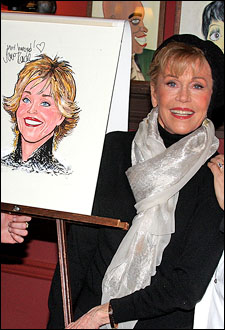
Baratz has been the house illustrator at Sardi's Restaurant in New York's theatre district for 35 years — a longer run than any of his three predecessors in the job. Landing that singular post, however, wasn't easy.
When Don Bevan retired in 1974, Vincent Sardi decided to hold a competition to find his new caricaturist. He sent notices to all of the local arts schools. One caught the eye of Baratz, then attending the School of Visual Arts.
"I was a little nervous about it," he said, "because I had never met any celebrities. I was pretty young. Even meeting Mr. Sardi, I was nervous about that."
Each applicant was tested by being given a subject to capture in pen and ink. Baratz draw Midler, then performing in her Broadway revue Clams on a Half Shell.
"The way I pictured her was mouth open, on stage, big smile," the artist said. The Divine Miss M was not pleased. "She didn't like the drawing, so I figured that was the end of that. But Mr. Sardi hung it up and people loved it in the restaurant. So he gave me another chance." Baratz was charged with depicting actor Anthony Hopkins, then starring on Broadway in Equus. The future Hannibal Lecter was overjoyed. "He loved it," remembered Baratz. "He invited me to the show. He took me out to lunch. It was a wonderful experience."
The week after that, Baratz was announced as Sardi's new caricaturist.
Like the hosts of the "Tonight" show, there have been few to have been as lucky. The first to paper the walls of theatredom's most famous eatery was Alex Gard, a well-known cartoonist at the time, who insisted he be paid only with a free meal every evening. He worked until he died in 1948. (Most of his drawings are now housed in the Billy Rose Theatre Collection of the New York Public Library.) John Mackey took over briefly, before playwright Don Bevan (Stalag 17) arrived for a considerably longer stay, turning out caricatures until 1974.
Baratz figures he averages about 20 caricatures a year, and has contributed roughly 700 to Sardi's three floors. Over those 700, he has learned to be as much a diplomat as an artist.
 |
||
| Jane Fonda and caricature |
||
| photo by Boneau Bryan Brown |
He continued, "People accuse me of leaning more toward portraiture. But I feel it's somewhere between caricature and portraiture. Political caricatures are biting and insulting. I feel in theatre they should be the opposite. Why can't they be? A caricature can be flattering, too, I feel."
Over the years, Baratz and Sardi's co-owner Max Klimavicius established a system by which new caricatures are created. The decision as to who gets honored appears to be up to Klimavicius (though one imagines he is frequently the target of pleas and suggestions from angling publicists and talent agents looking to promote their show or client).
Klimavicius then sends a picture of the subject by computer. (Baratz — who also works as engraver for the Bureau of Engraving and Printing, designing stock certificates and traveler's checks — moved to Texas in 2003.) Many times the artist does not know they're about to be framed and placed on Sardi's storied walls. Baratz works out an 11-by-14-inch sketch in pencil or pen and ink (pictures of New York City Mayors are slightly larger). "I look at the photo very carefully, and see what interested me in their personality. Usually I know them from their stage work, and I try to grab something out of that."
He then sends it by UPS to Max for approval. "Sometimes I have to redraw it many times," said Baratz. "It is a process. Max has a very good eye for that. He knows these people."
One subject he had trouble getting quite right was La Cage aux Folles actor Gene Barry. "I did him like six times," Baratz remembered. "Even the waiters used to make fun of me. 'Oh, he's coming with another Gene Barry.'" Finally, Barry himself put a stop to the endless attempts. "He sat with his agent one day for lunch. The agent asked the waiter to bring one of the drawings over. He liked it and ended up signing it. And it went on the wall."
Once the caricature is completed, the artist is invited to see it, and the drawing is toasted over Champagne in a brief ceremony. Typically the honored subject is pleased — or, if they're not pleased, they keep their mouths shut, considering themselves fortunate to be in the Sardi's pantheon.
There is, however, the rare bird who doesn't want the caricature at all. "Years ago I did critic Walter Kerr," told Baratz, "who had already been done by the previous caricaturist. Mr. Sardi said, 'It's about time we do Jean Kerr,'" referring to Kerr's playwright wife, who wrote Mary, Mary, among other works. "So I called Mr. Kerr and he was very polite on the phone. He was thrilled. He said, 'I'll get Jean.' She gets on the phone, and she said, 'Mr. Baratz, you're 30 years too late.' Boom! She hung up the phone."











